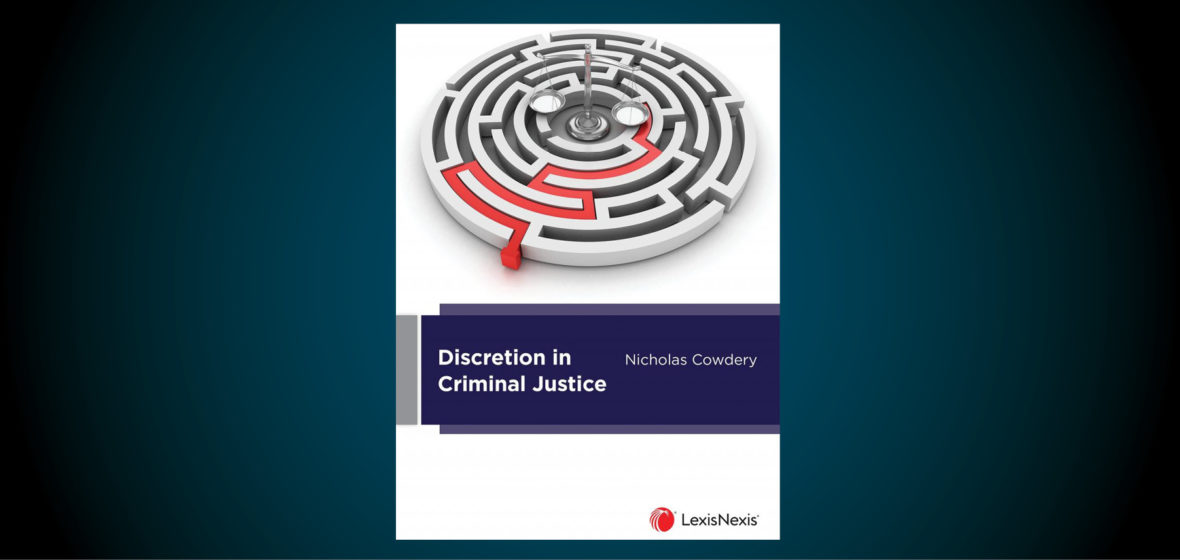With his 16 years as Director of Public Prosecutions in NSW, Nicholas Cowdery QC is a respected thought leader on all aspects of criminal justice.
He came to the position of DPP after more than two decades in criminal practice at the Sydney Bar and as a PNG public defender. During his time as Director, Cowdery shaped NSW prosecution policy as well as influencing the broader criminal procedure policies in that state. Since Cowdery stepped down as DPP he has been teaching the course, Discretion in Criminal Justice, at the University of Sydney, meaning this (230 page) book condenses both depth and breadth of its very large topic while also offering an opportunity to get into the head of the eminently fair and reasonable prosecutor.
A particular virtue of this book is it places front of mind the numerous instances where discretion operates, and it guides the reader through the literature and case law that reiterates that discretionary decisions are never completely unfettered. Cowdery summarises the broad principles that set boundaries on the exercise of discretion in legal decision making, noting that the touchstones of reasonableness and impartiality and advancing the common good all shape the exercise of discretion.
Cowdery draws on the iconic High Court case of House for expression of the fundamental principles that shape appropriate discretionary decision making, usefully referring to the pithy summary by Justice Starke, who on noting the significant width of the judicial discretion in the sentencing context before that court, observed that no court can interfere with its exercise if the discretion was exercised judicially, “according to rules of reason and justice, and not arbitrarily or capriciously or according to private opinion.” As the majority in House indicated, while the discretionary judgment before the Court was severe, it was not “unreasonable or clearly unjust”. Nor was there a basis to establish “that it arose from error of fact or of law, or failure to take into account any material consideration, or from giving undue weight to any circumstance or matter”. In other words, House did not present the appeal court with room to move. However, this is not always the case.
While these broad principles frame characteristics of perverse and improper exercises of discretionary judgment, this book does not leave principles in abstraction. The bulk of the book very usefully offers readers clear and explicit scaffolding for evaluating discretionary determinations in particular contexts, and as mentioned, Cowdery’s breadth and depth of experience comes to the fore particularly when he examines fields central to prosecution practice.
Chapters 3-6 address the exercise of discretion in investigation, in bail and prosecution pre-trial determinations, including charge resolution and agreement of facts. There is a useful summary of how s 15A Director of Public Prosecutions Act 1986, enacted in 2001, came into play and on how, in practical terms, an accused obtains disclosure of documents held by police. Cowdery addresses the important cases of JB and Edwards, though understandably given the scope of the book, the treatment is somewhat condensed, leaving the reader who wishes to explore the cracks that exist in the disclosure regime to go to these judgments and subsequent applications. For new criminal lawyers facing the need to negotiate charges, Chapter 6 sets out key considerations, including a very useful checklist. This chapter is practical and comprehensive. It would have been useful to have included more discussion of the pivotal role of the prosecutor in the New South Wales EAGP Scheme, but perhaps Cowdery considered the scheme not sufficiently bedded down, and even with only a brief mention of this scheme the opportunity to draw on a prosecutor’s manual for charge negotiation remains extremely valuable.
Other particularly useful sections are those on legal obligations and best practice pertaining to victims in Chapters 5 and 6. Victims’ rights is placed in the broad international context with a useful guide to how the various Charter of Victims’ Rights (NSW), the National Charter of Victims’ Rights and the Victims’ Rights Act 1996 (NSW), Victims’ Rights and Support Act 2013 (NSW) came into being, and operate, including also discussion of the establishment and role of the Witness Assistance Service (WAS).
Finally, the pair of chapters (Chapters 11 and 12) on sentencing reveal Cowdery’s depth of knowledge and experience in this domain. As with other sections of the book, Cowdery frames the chapters with broad principles before descending into the weeds of the Crimes (Sentencing Procedure) Act 1999 (NSW). He sets out the alternatives to custodial punishments and a summary of how to approach guiding discretion in sentencing matters, including the role of guideline judgments (that is, on suggested sentencing ranges, appropriate starting points, and considerations relevant to aggravation or mitigation) before summarising guideline judgments for dangerous driving, high range PCA, armed robbery, importation of drugs, break, enter and steal, discount for plea of guilty, contrition, cooperation, taking other matters into account. Cowdery summarises the policy issues relevant to guideline judgments, including a critical analysis of their effect in particular spheres of sentencing.
Inevitably this book will attract a relatively niche market. An aspect of Cowdery’s experience that comes into play, and may be useful for criminal law practitioners, is that he explains how and why legislative steps were taken so that those with a practical but relatively decontextualised understanding of legal developments will find new insights from Cowdery’s joining of these dots. Discretion in Criminal Justice will be a go-to guide for those who practice irregularly in criminal matters or who are new to the field and wish to be well-armed for the sudden need to respond to issues relating to disclosure, charge negotiation, victims’ rights or to make sentencing submissions. While the book is far broader than these areas, these topics are undoubtedly its strengths.




